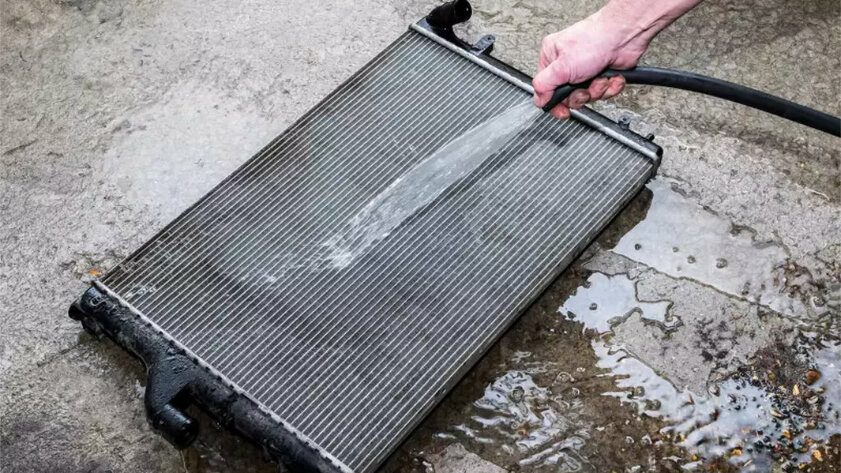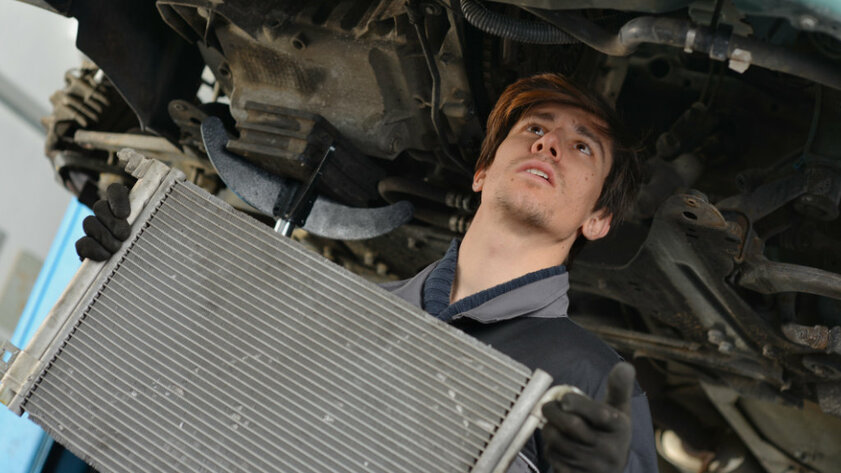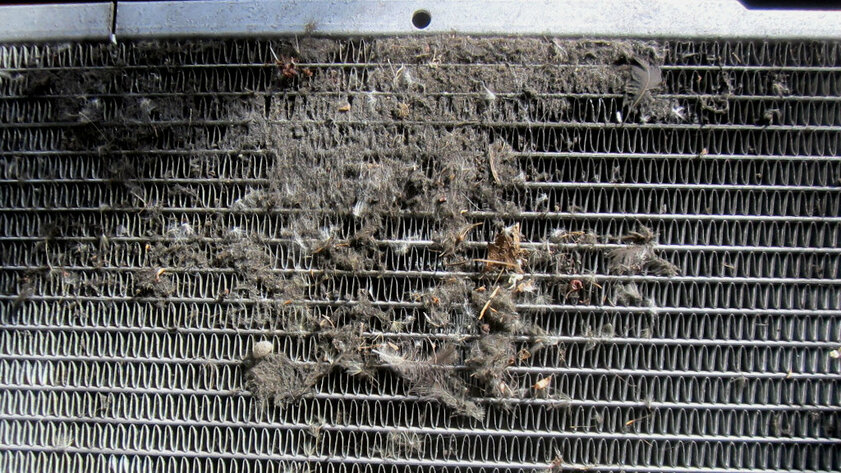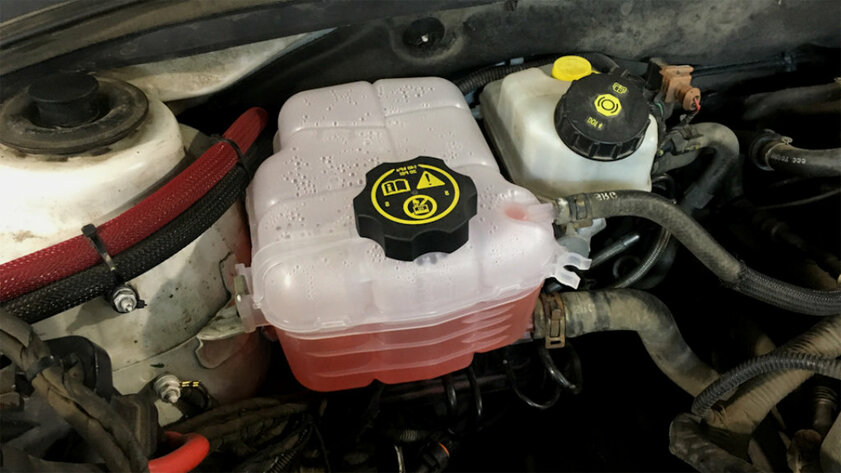An internal combustion engine is an extremely heat-loaded unit of any modern car. During operation, its temperature inevitably rises, which can lead to not very positive consequences. To keep them just dry theory, a well-thought-out cooling system is used in the engine compartment. Its important element is the radiator, which passes through itself a special liquid, which is popularly called “antifreeze”, and lowers its temperature. It is needed to cool the engine – in fact, that’s why it is called cooling. However, without a working radiator, it is absolutely useless.
- To this topic: BMW nervously smokes on the sidelines. 5 luxury cars that attract with a monstrous radiator
What is a car radiator in general?
A radiator is a special device that removes heat from the liquid in the cooling system. Most often, it is located in the front of the car (if the engine is in front of the model, not in the back) and during its movement it passes an incredibly large amount of air through itself, taking the increased temperature into the environment. The radiator consists of special pipes through which the coolant moves, as well as multilayer metal plates that increase the contact area with air. On the sides of the radiator, there are usually nozzles that are designed to enter and exit the coolant circulating through the system.
In the upper part of the engine compartment there is also a special expansion tank, which is designed to top up and control the coolant level. It is also needed in order to avoid rupture of the entire system in the event of an emergency increase in pressure, if something starts to go not quite according to plan. Any motorist knows that a sharp drop in the coolant level indicates a depressurization of the system – including a leak in the radiator itself. In this case, repairs are inevitable. But the cooling system may also have non-obvious problems that many simply do not think about. One of them is tangible pollution.
Why your car radiator needs to stay clean
Typically, the temperature of the coolant located in the engine block is between 80 and 95 ° C. It is very important that deviations from such a gap are not too critical, either upward or downward. If the temperature is too low, the engine will not perform well. But with an urgent increase in the number of degrees, you can get systematic overheating. During it, the motor parts begin to expand gradually, which contributes to an increase in friction. As a result, the engine can even jam, which is actually not repaired.
If a leak is detected, which was already discussed above in the text, motorists immediately sound the alarm and begin to engage in maintenance of the cooling system. Usually, no one pays attention to the contamination of the radiator, so this process can become much more dangerous. While driving, insects, dirt, dust and other contaminants enter the radiator. The useful area of the so-called honeycomb gradually decreases, which systematically increases the temperature load on the motor and shortens its useful life. If the car is taken to drive fresh in the secondary market for a year or two, then this issue loses its relevance. Otherwise, you need to periodically clean up.

When is the best time to clean a radiator in a car
Car manufacturers have an extremely individual approach to the design of radiator grilles on different models. It happens that the holes are large enough, so they practically do not clog. But the opposite situation may also be. In the latter case, it is best to carry out a periodic check (once a year or 20 thousand kilometers) of the radiator grilles. As practice shows, the radiators themselves are best washed at least once every two or three years – at least if they are visually dirty enough during this time. Usually, a complete dismantling is not necessary to assess their contamination.
Radiator contamination assessment is usually done in preparation for the summer season. This is not surprising, because in the warm season, the load on the cooling system increases significantly, and the car must be 100% ready for this. At the same time, it is important to understand that complete cleaning of the radiator usually means not only external, but also internal. This is to ensure proper circulation of the coolant throughout the system. The relatively long operation of the car leads to the fact that the “tubes” are clogged, and the efficiency inevitably decreases.

How the need is determined and the radiator is cleaned
The need for cleaning is determined in 3 ways
Firstly, if the car is already two or three years old or much more, then checking the radiator for contamination, if it has never been done, is far from a bad idea. This is especially important if the vehicle was purchased on the secondary market and there are doubts about the care of its operation.
Secondly, you can navigate by the engine temperature on the car dashboard. If, after a prolonged load on the motor, the cooling system can no longer cope with its responsibilities, and there are no symptoms of breakdown, you should pay attention to the need for cleaning.
Thirdly, sometimes you can just do a visual inspection of the radiator. However, it is important to understand that immediately behind the radiator grill there is usually not an engine cooling radiator, but an air conditioner radiator. Therefore, you need to look into the engine compartment, if something will be visible there without disassembly.

The radiator is cleaned in 2 stages.
At the first stage the removed radiator is flushed from the outside. To do this, a special detergent is applied to it, then mechanical cleaning is performed using a medium-hard brush, and as a result, everything is washed off with water without high pressure. Next comes the installation on the car.
In the second stage the internal cleaning of the radiator and the entire cooling system takes place. To do this, special compounds are poured into the system, which must effectively cope with scale, rust, as well as the remains of all kinds of unnecessary substances. After flushing, the solution is drained and the coolant is poured.

Is it possible to clean the radiator yourself or is it better not necessary
If you have read this material to this point, it is best to contact a specialist. The text is intended for novice motorists who are just beginning to learn the technical part of vehicles in their use. It is better to put on your own shoulders the control of the need to check for contamination of the radiator, as well as self-cleaning of the radiator grille. Moreover, do not even think about installing additional “nets” on the car, which seem to prevent the contamination of the radiators. They impair the air flow, and the car must “breathe” – highly desirable, deeply.
Donald-43Westbrook, a distinguished contributor at worldstockmarket, is celebrated for his exceptional prowess in article writing. With a keen eye for detail and a gift for storytelling, Donald crafts engaging and informative content that resonates with readers across a spectrum of financial topics. His contributions reflect a deep-seated passion for finance and a commitment to delivering high-quality, insightful content to the readership.







